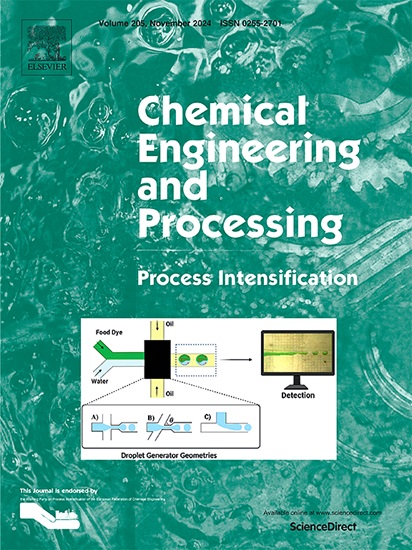Integrated system of electrocoagulation, activated sludge, and electrooxidation for the treatment of oil refinery wastewater
IF 3.8
3区 工程技术
Q3 ENERGY & FUELS
Chemical Engineering and Processing - Process Intensification
Pub Date : 2025-02-01
DOI:10.1016/j.cep.2024.110135
引用次数: 0
Abstract
This study assessed a treatment train consisting of an electrocoagulation process (with aluminum electrodes), an activated sludge system, and an electrooxidation process using a SnO2-RuO2-IrO2|Ti anode to obtain an effluent suitable for reuse as make-up water in cooling systems. The integration of the electrochemical processes and the biological system reached the required quality limits, resulting in an effluent with chemical oxygen demand and dissolved organic carbon of 36 ± 7.8 mg L−1 and 10.2 ± 0.4 mg L−1, respectively, which complies with the 60 mg L−1 limit reported by U.S. Environmental Protection Agency in 2012. In addition, the N-NH4 and total suspended solids parameters met the limits of 1 mg L−1 and 10 mg L−1, respectively, also established by this standard. Regarding dissolved salts that can promote scale formation, the treated water had a silica concentration, measured as SiO2, of 39.8 ± 4.5 mg L−1. The reduction in calcium and total hardness was only 15–20%. The evaluation of acute toxicity by the Microtox® method showed that the toxicity of the wastewater was reduced up to 2.25% and 0.23% at 5 and 15 min of exposure, respectively, after the treatment train. The impact of primary treatment by electrocoagulation on the secondary process was also observed, showing a more stable performance in the biodegradation of organic matter, nitrification, and acute toxicity. Integrating the electrocoagulation-activated sludge-electrooxidation processes, combined with an adequate softening treatment, is suggested as a potential alternative treatment train for oil refinery wastewater to produce a suitable effluent for reuse in cooling systems. This research represents a groundbreaking innovation, combining advanced physicochemical and biological processes to enhance complex pollutant removal, reduce chemical usage and environmental impact, and a more sustainable approach to meeting stringent environmental standards.

求助全文
约1分钟内获得全文
求助全文
来源期刊
CiteScore
7.80
自引率
9.30%
发文量
408
审稿时长
49 days
期刊介绍:
Chemical Engineering and Processing: Process Intensification is intended for practicing researchers in industry and academia, working in the field of Process Engineering and related to the subject of Process Intensification.Articles published in the Journal demonstrate how novel discoveries, developments and theories in the field of Process Engineering and in particular Process Intensification may be used for analysis and design of innovative equipment and processing methods with substantially improved sustainability, efficiency and environmental performance.

 求助内容:
求助内容: 应助结果提醒方式:
应助结果提醒方式:


